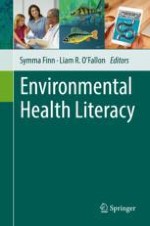2019 | OriginalPaper | Chapter
10. The Use of Digital Communication Channels to Enhance Environmental Health Literacy
Authors : Gary L. Kreps, Kevin Wright, Amelia Burke-Garcia
Published in: Environmental Health Literacy
Publisher: Springer International Publishing
Activate our intelligent search to find suitable subject content or patents.
Select sections of text to find matching patents with Artificial Intelligence. powered by
Select sections of text to find additional relevant content using AI-assisted search. powered by
